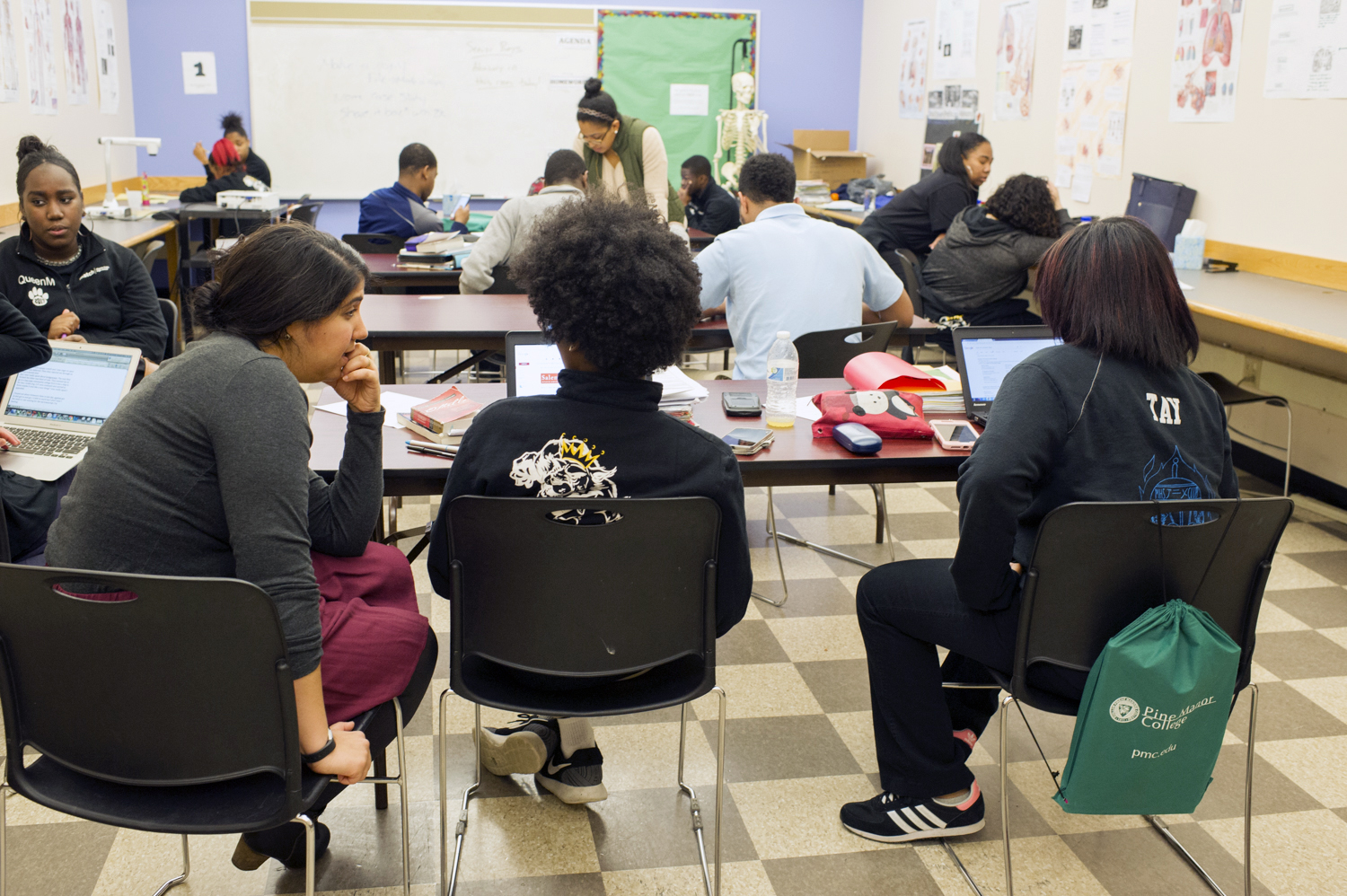
Match Charter college counselor Shira Zar-Kessler talks with senior Michaela Notice about her college decision. (WGBH/Kim Palmer)
Monday marks the decision deadline for many high school seniors deciding where to go to college.
As students ponder their choices, worrying about details like average class sizes and the types of majors offered at different schools, there is another factor that merits attention. Perhaps more than anything else, a student's family educational background affects their college attendance and whether that student graduates on time — or at all.
WGBH's higher education desk has been visiting a high school in Boston, which has found a way to send more low-income, minority students to college.
It's the end of a long school day at Match Charter Public School on Commonwealth Avenue, and senior Aneudy Polanco is tired.
For the past four years, he's been balancing his school work, his job as a cashier at T.J. Maxx, babysitting his younger siblings, baseball practice and his college applications.
"At one point I was like, 'Do I really want to go to college?'” Aneudy said. “But I pulled through and got it done."
Most of the 300 students here at Match are like Aneudy. Many don’t speak English at home. Half are what the district designates as poor. And while their parents want them to go to college, they often don't know how to navigate the system.
A new report by the American Academy of Arts & Sciences finds 81 percent of American high school graduates from high-income families immediately enroll in college. That's compared with only 52 percent of students from low-income families. Also, the report says, 40 percent of low-income college students never show up for class in the fall even after they’ve been accepted.
And that’s, in part, why Match – beginning in middle school – gives these students a lot of college counseling.
"We want our deposits in by May 1st," guidance counselor Shira Zar-Kessler told her students on a recent afternoon, standing in the front of the class. "There is the possibility that some of us won't be able to make that decision by May 1st. If that is the case then we need to call our top two or three schools and ask for an extension."
By senior year, the school requires all seniors attend these college guidance classes twice a week.
After class, Aneudy and his mom Seanny Nova meet with Zar-Kessler and together they review his college choices and payment plans.
"Did you hear from UMass Boston?" Zar-Kessler asks.
"Yes," Aneuday responds modestly.
"Was I right," Zar-Kessler responds.
Match requires students apply to at least ten schools. Aneudy got into five, including UMass Boston. Now he says he's torn between UMass Amherst and UMass Lowell, the two schools that offered him the most financial aid.
"In terms of social fit, do you feel like there's a difference?" Zar-Kessler asks Aneudy.
"Amherst is way bigger,” Aneudy says, pointing out that it might be a better fit.
Zar-Kessler grew up in Boston’s more affluent suburbs, where some families pay for this kind of college coaching or pricey summer programs at elite universities.
“A lot of what I did to apply to college was at home,” Zar-Kessler said. “It was like ‘OK, I had one meeting with my guidance counselor,’ and they were like, 'This looks good. Cool.’”
At Match, she says it’s the exact opposite.
“Everything happens here,” Zar-Kessler said. “We have parents come in and we have discussions with parents. The lists, the essays, the supplements the applications. All of that. The financial aid. It all happens in this building.”
Earlier: How One Affluent Town Helps Its Neediest Students Get Into (And Stay In) College
Match also has elementary schools in Boston, so it instills this college-going culture early by telling students to dream big.
And for students who can stay in the program through high school it works.
Today, nearly 90 percent of the school's graduates go on to a four-year college.
Zar-Kessler says this college push creates seemingly endless paperwork and leads to a lot of decision making.
“And that’s a really hard thing to do even as a 17-year-old,” Zar-Kessler said. “To figure out what could possibly be [the best fit] at 17 can be really hard to do.”

Match Charter High School senior Aneudy Polanco is leaning toward UMass Lowell, which gave him the most financial aid. (WGBH/Kim Palmer)
With just a few days before decision day, Aneudy's mom, who works as a nursing assistant, wants him to attend UMass Amherst, the state's flagship campus, even though it will cost her more and she will have to work overtime.
"It's his decision," she says. "I'm going to be there for him any decision he makes."
Aneudy, though, tells me that he's leaning toward UMass Lowell, which gave him the most financial aid.
"I just don't want to have a lot of debt, and I don't want to put a lot of debt to my mom,” Aneudy said. “Especially because I have three other little siblings that she has to take care of."
Aneudy will make his decision public at a school ceremony next month, when seniors will announce their college choices in front of their family and friends.
This story was a collaboration between WGBH News and The Hechinger Report, a nonprofit independent news organization focused on inequality and innovation in education.










